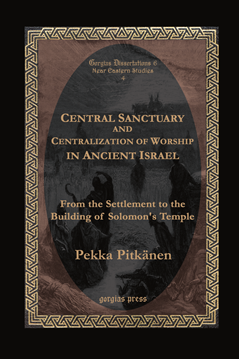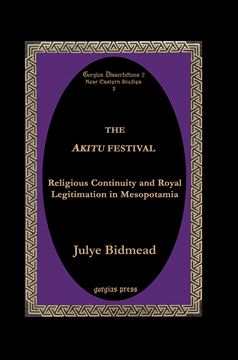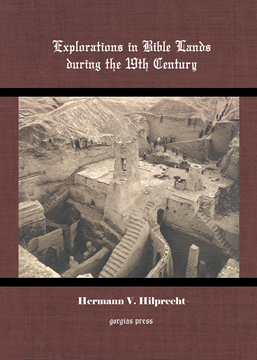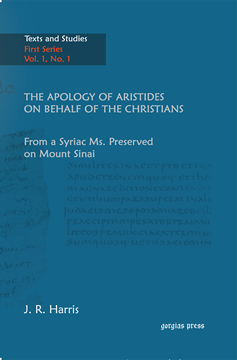Central Sanctuary and Centralization of Worship in Ancient Israel
From the Settlement to the Building of Solomon's Temple
Series: Gorgias Near Eastern Studies 6
ISBN: 1-59333-157-6
This book provides the first major reinvestigation and reinterpretation of the history of centralization of worship in ancient Israel since de Wette and Wellhausen in the nineteenth century. Old Testament scholarship has thus far relied on the consensus that the book of Deuteronomy is the product of late monarchic Judah (7th century BC). Pitkanen places the biblical material in its archaeological and ancient Near Eastern context and pays special attention to rhetorical analysis. The author suggests that the book of Joshua, as well as its sources (such as Deuteronomy) may have originated as early as before the disaster of Aphek and the rejection of Shiloh.
$124.00 (USD)
Healing in the Theology of Saint Ephrem
ISBN: 1-59333-156-8
Ephrem, the most celebrated writer of the Syriac Church, presents a wide range of theological themes and images that are characteristic of fourth-century Syrian Christianity. A significant theme that no one has yet studied in Ephrem is the concept of sickness and healing. This book presents the significance of healing theology and the ways in which the healing of man - spiritually, mentally, and corporally - is highly valued by Ephrem. The main part of the book deals with the causes of spiritual sickness and the process of healing, and the way in which Ephrem places them in the divine history of salvation.
$207.00 (USD)
The Akītu Festival (hardback)
Religious Continuity and Royal Legitimation in Mesopotamia
Series: Gorgias Near Eastern Studies 2
ISBN: 1-59333-158-4
The akītu festival is one of the oldest recorded religious festivals in the world, celebrated for several millennia throughout ancient Mesopotamia. Yet, the akītu was more than just a religious ceremony; it acted as a political device to ensure the supremacy of the king, the national god, and his capital city. Using tools of social anthropology and ritual analysis, this book presents a detailed reconstruction of the festival events and its attendant rituals to demonstrate how the festival became a propagandistic tool wielded by the monarchy and ruling classes. The akītu festival demonstrates the effectiveness of religion as a political tool.
$124.00 (USD)
A Form-Critical Analysis of the Admonitions in 4QInstruction
Series: Gorgias Near Eastern Studies 3
ISBN: 1-59333-159-2
This study provides background on wisdom forms, the key Qumran sectarian texts, and wisdom studies related to the Dead Sea Scrolls. 4QInstruction includes poetic discourses, hymnic material, and short wisdom sayings and admonitions. A major focus is placed on the admonitions, which are discussed in terms of their structure, wisdom forms, and setting. The admonitions are expressed in biblical wisdom forms, showing a familiarity with and acceptance of traditional Hebrew wisdom, including a focus on traditional themes. Yet, when read from the sectarian perspective, 4QInstruction reinforces the guidelines and theology of the key Dead Sea Scroll documents.
$99.00 (USD)
Comparative Edition of the Syriac Gospels (4-volume set)
ISBN: 1-59333-257-2
This new edition conveniently provides the text of all three versions of the Syriac Gospels in one place for the first time. Drawn from the best sources, they are carefully aligned so that their inter-relationship can immediately be seen and studied.
From $116.00 (USD)
Explorations in Bible Lands During the 19th Century
ISBN: 1-59333-116-9
This book is a historical sketch of archaeological explorations of the biblical lands of Assyria, Babylonia, Palestine, Egypt, Arabia and Hittite areas. It conceives the resurrection of the principal ancient nations of Western Asia and Egypt. Contains nearly 200 illustrations and four maps.
$144.00 (USD)
Monks and Monasteries of the Near East
By Jules Leroy
ISBN: 1-59333-276-9
Jules Leroy, the French art expert, spent several months touring the Near East in search of Early Christian remains. During this time he visited most of the monasteries in Egypt, Syria, the Lebanon, Palestine, and Iraq.
$96.00 (USD)
The Lord's Prayer in the Early Church
Series: Texts and Studies (First Series) Vol 1, No. 3
ISBN: 1-59333-275-0
The late Cambridge scholar F. H. Chase gives an insightful study on the Lord's prayer in the early Christian Church. The study first discusses the early Church and the Synagogue, then goes through an analytical study of every phrase of the prayer.
$132.00 (USD)
The Passion of S. Perpetua
Series: Texts and Studies (First Series) Vol.1, No.2
ISBN: 1-59333-277-7
The story of the two women martyrs S. Perpetua and her slave S. Felicitas (d. 203 CE) have captivated generations of Christians. In this book, the late Cambridge scholar J. A. Robinson provides a study of the Greek and Latin texts of the Passio based on newly discovered manuscripts, as well as the original Latin text of the Scillitan Martyrs, another text of late 2nd century North African martyrdom.
$120.00 (USD)
The Apology of Aristides on behalf of the Christians
Series: Texts and Studies (First Series) Vol.1, No. 1
ISBN: 1-59333-278-5
The Apology of Aristides is the earliest Christian apologia to have survived in its entirety. It was written as a defense of the new Christian way of life against its many rivals and opponents, and details some of its leading ethical precepts. Long thought to have been lost, this early second-century work was rediscovered in a Syriac translation in a seventh-century manuscript preserved in the monastery of St. Catherine on Mount Sinai. This volume contains not only the standard edition of the Syriac text with critical notes, but also the first English translation and a study of surviving fragments in Greek, which were subsequently identified in the 'Life of Barlaam and Josaphat' (an early Christian reworking of the life of Buddha).
$124.00 (USD)









